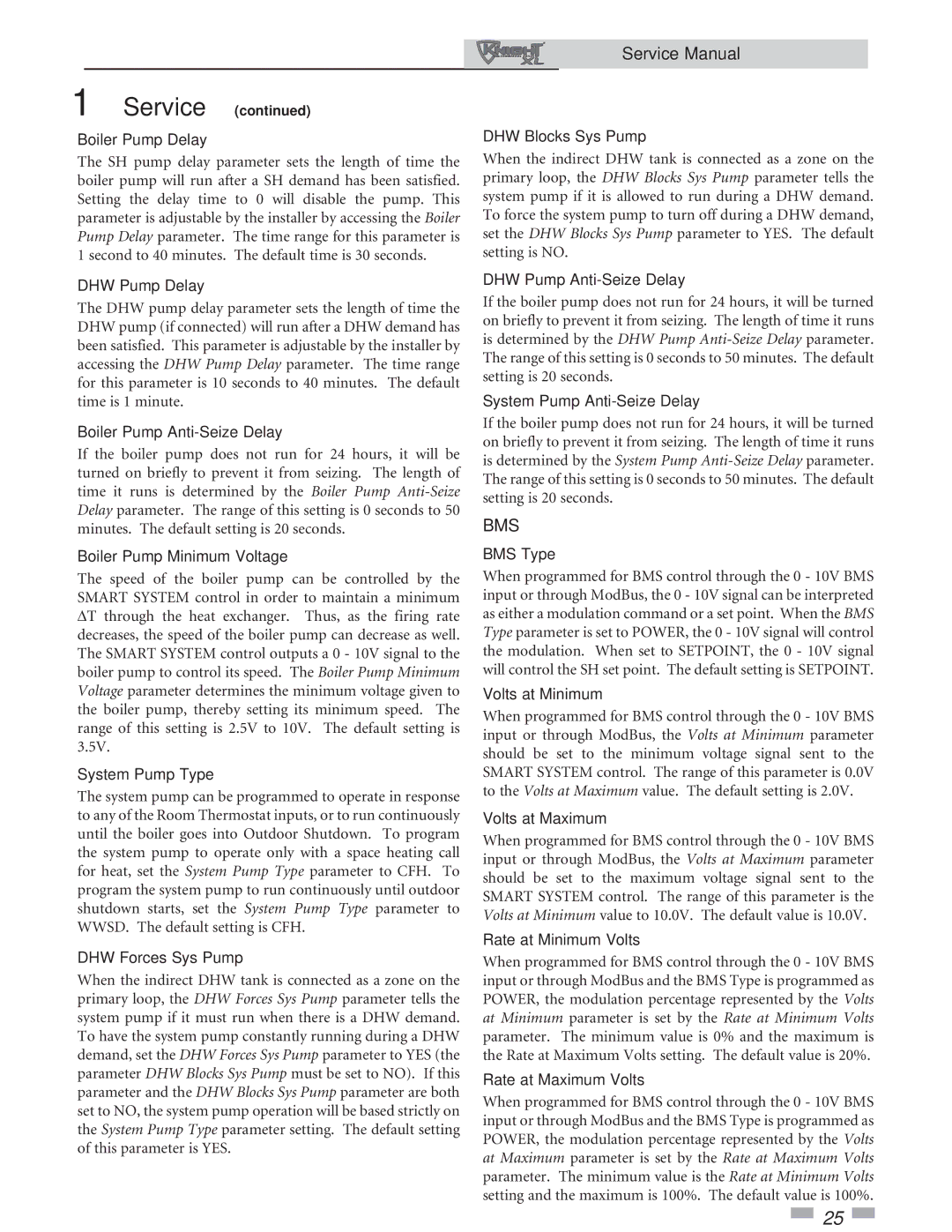1 Service (continued)
Boiler Pump Delay
The SH pump delay parameter sets the length of time the boiler pump will run after a SH demand has been satisfied. Setting the delay time to 0 will disable the pump. This parameter is adjustable by the installer by accessing the Boiler Pump Delay parameter. The time range for this parameter is 1 second to 40 minutes. The default time is 30 seconds.
DHW Pump Delay
The DHW pump delay parameter sets the length of time the DHW pump (if connected) will run after a DHW demand has been satisfied. This parameter is adjustable by the installer by accessing the DHW Pump Delay parameter. The time range for this parameter is 10 seconds to 40 minutes. The default time is 1 minute.
Boiler Pump Anti-Seize Delay
If the boiler pump does not run for 24 hours, it will be turned on briefly to prevent it from seizing. The length of time it runs is determined by the Boiler Pump Anti-Seize Delay parameter. The range of this setting is 0 seconds to 50 minutes. The default setting is 20 seconds.
Boiler Pump Minimum Voltage
The speed of the boiler pump can be controlled by the SMART SYSTEM control in order to maintain a minimum ΔT through the heat exchanger. Thus, as the firing rate decreases, the speed of the boiler pump can decrease as well. The SMART SYSTEM control outputs a 0 - 10V signal to the boiler pump to control its speed. The Boiler Pump Minimum Voltage parameter determines the minimum voltage given to the boiler pump, thereby setting its minimum speed. The range of this setting is 2.5V to 10V. The default setting is 3.5V.
System Pump Type
The system pump can be programmed to operate in response to any of the Room Thermostat inputs, or to run continuously until the boiler goes into Outdoor Shutdown. To program the system pump to operate only with a space heating call for heat, set the System Pump Type parameter to CFH. To program the system pump to run continuously until outdoor shutdown starts, set the System Pump Type parameter to WWSD. The default setting is CFH.
DHW Forces Sys Pump
When the indirect DHW tank is connected as a zone on the primary loop, the DHW Forces Sys Pump parameter tells the system pump if it must run when there is a DHW demand. To have the system pump constantly running during a DHW demand, set the DHW Forces Sys Pump parameter to YES (the parameter DHW Blocks Sys Pump must be set to NO). If this parameter and the DHW Blocks Sys Pump parameter are both set to NO, the system pump operation will be based strictly on the System Pump Type parameter setting. The default setting of this parameter is YES.
Service Manual
DHW Blocks Sys Pump
When the indirect DHW tank is connected as a zone on the primary loop, the DHW Blocks Sys Pump parameter tells the system pump if it is allowed to run during a DHW demand. To force the system pump to turn off during a DHW demand, set the DHW Blocks Sys Pump parameter to YES. The default setting is NO.
DHW Pump Anti-Seize Delay
If the boiler pump does not run for 24 hours, it will be turned on briefly to prevent it from seizing. The length of time it runs is determined by the DHW Pump Anti-Seize Delay parameter. The range of this setting is 0 seconds to 50 minutes. The default setting is 20 seconds.
System Pump Anti-Seize Delay
If the boiler pump does not run for 24 hours, it will be turned on briefly to prevent it from seizing. The length of time it runs is determined by the System Pump Anti-Seize Delay parameter. The range of this setting is 0 seconds to 50 minutes. The default setting is 20 seconds.
BMS
BMS Type
When programmed for BMS control through the 0 - 10V BMS input or through ModBus, the 0 - 10V signal can be interpreted as either a modulation command or a set point. When the BMS Type parameter is set to POWER, the 0 - 10V signal will control the modulation. When set to SETPOINT, the 0 - 10V signal will control the SH set point. The default setting is SETPOINT.
Volts at Minimum
When programmed for BMS control through the 0 - 10V BMS input or through ModBus, the Volts at Minimum parameter should be set to the minimum voltage signal sent to the SMART SYSTEM control. The range of this parameter is 0.0V to the Volts at Maximum value. The default setting is 2.0V.
Volts at Maximum
When programmed for BMS control through the 0 - 10V BMS input or through ModBus, the Volts at Maximum parameter should be set to the maximum voltage signal sent to the SMART SYSTEM control. The range of this parameter is the Volts at Minimum value to 10.0V. The default value is 10.0V.
Rate at Minimum Volts
When programmed for BMS control through the 0 - 10V BMS input or through ModBus and the BMS Type is programmed as POWER, the modulation percentage represented by the Volts at Minimum parameter is set by the Rate at Minimum Volts parameter. The minimum value is 0% and the maximum is the Rate at Maximum Volts setting. The default value is 20%.
Rate at Maximum Volts
When programmed for BMS control through the 0 - 10V BMS input or through ModBus and the BMS Type is programmed as POWER, the modulation percentage represented by the Volts at Maximum parameter is set by the Rate at Maximum Volts parameter. The minimum value is the Rate at Minimum Volts setting and the maximum is 100%. The default value is 100%.
 25
25 
